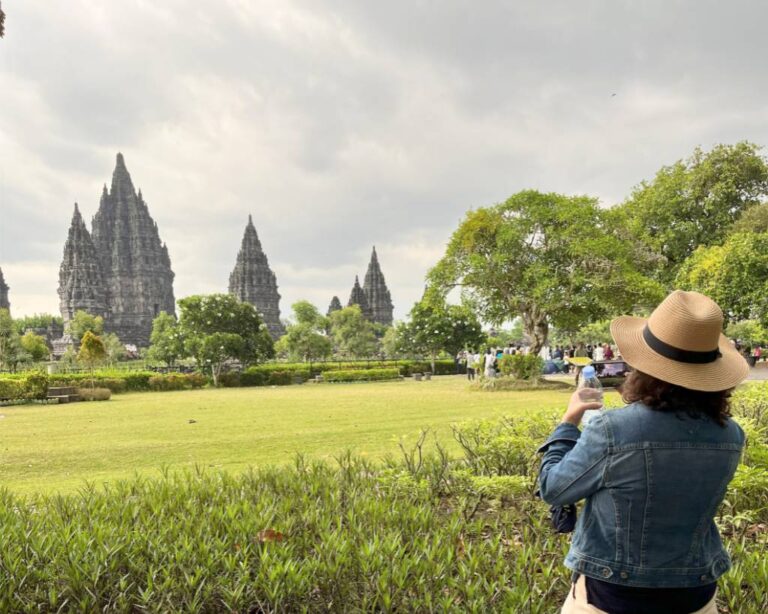This post contains affiliate links. If you make a purchase through these links, I can earn a commission at no extra cost to you. Thank you!
If you are planning to spend any time in Yogyakarta, visiting Prambanan Temple should be on your list of must-see places. This UNESCO World Heritage site is truly an architectural marvel and is one of the top attractions in Southeast Asia.
In December, I was able to spend two days in Yogyakarta. Unfortunately, December is also right in the middle of the rainy season. While I was hoping for a dry two days, that wasn’t the case. It only rained one day, the day I was visiting Prambanan Temple.
Was it ideal? No. Would I visit in the rain again? Absolutely!
Keep reading to find out what happens when it rains and why you must see it!

Shiva Temple
Why You Should Visit in the Rain
Visiting Prambanan Temple on a rainy afternoon in Yogyakarta was truly a magical experience. Of course, the day didn’t start out with rain. It was very hot and humid, but still quite pleasant. Then the skies opened up, and everyone scrambled trying to find cover.
This was not how I envisioned my visit to Prambanan Temple.
As I stood huddled under a small overhang at the entrance, I debated about going back out there to finish exploring the temple grounds.
The rain didn’t look like it was going to stop anytime soon and I had already seen a good bit of the temple grounds. I was disappointed in the weather but still satisfied with what I had seen of the temple grounds.
Then I noticed something from a distance.
The rainwater coming off the temples didn’t look quite right. It looked like the temples had become water fountains of sorts. I had to go and take a closer look. I was already soaking wet, so why not?
I’m so glad I did!
I stood there in awe of the towering structures, rainwater cascaded down the ancient stone walls, flowing gracefully out of the statues’ mouths. The temples DID become water fountains!
What an incredible sight!
I felt so blessed to witness something that most people don’t even get a chance to see…all because it rained!
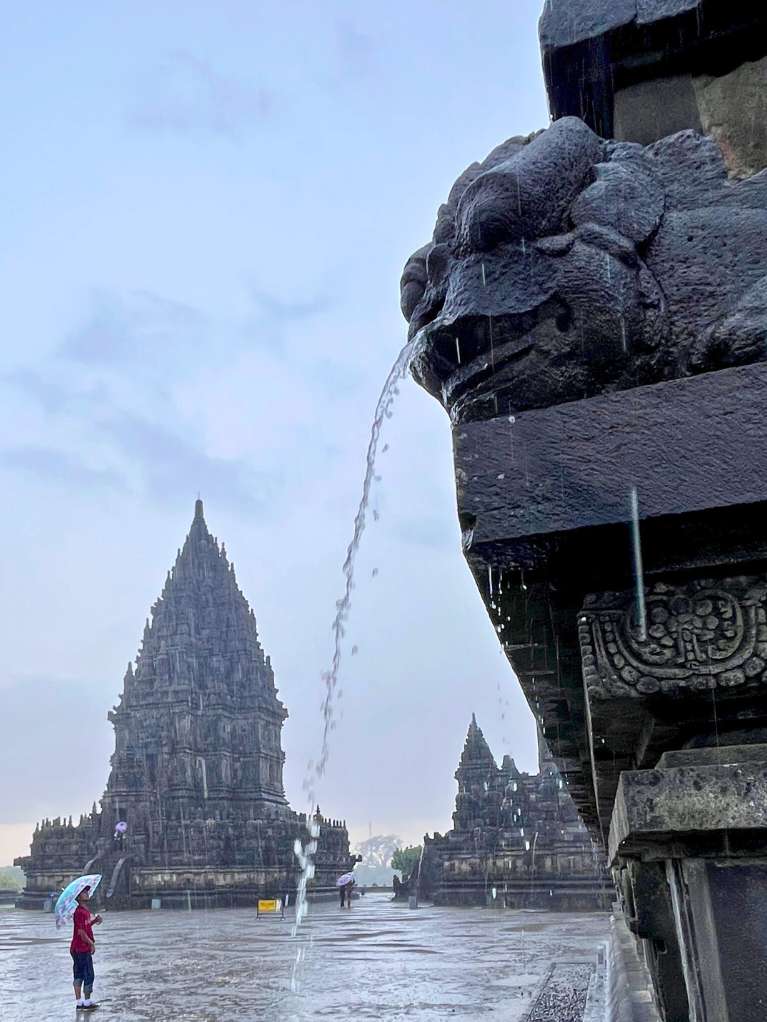
Truly an architectural marvel!
History of Prambanan Temple
Prambanan Temple, or Candi Prambanan, is the largest Hindu temple complex in Indonesia. Constructed in the 9th century during the reign of the Sanjaya Dynasty, it was dedicated to the Trimurti: Brahma the Creator, Vishnu the Preserver, and Shiva the Destroyer.
The main temple, dedicated to Shiva, towers majestically at 154 feet tall, surrounded by smaller shrines.
The temple complex was abandoned in the 10th century, likely due to volcanic eruptions and political shifts, and it fell into ruins. Rediscovered in the 19th century, restoration efforts began in the 20th century, reviving its former glory.
Layout and Different Sections
Prambanan is a vast complex with hundreds of temples and shrines covering about 95 acres. Many of them in varying degrees of ruins. The temple grounds are a combination of stone and dirt paths. When it rains, the ground will become muddy and slippery, so be extra careful.
There are three main temples in the central courtyard dedicated to Shiva, Brahma, and Vishnu. Each one is accompanied by a smaller temple for the animal that they used as their vehicle. Garuda, the mighty bird, is Vishnu’s mode of transportation, while Nandi, the sacred bull, is Shiva’s.
The central courtyard also houses various smaller shrines and structures, creating a labyrinth of stone and spirituality. Wandering through the maze you can’t help but explore and contemplate life.
Shiva Temple
The Shiva Temple is the largest and most significant temple, standing at 154 feet. It contains several chambers, with the main chamber housing a statue of Shiva Mahadeva. The walls are adorned with intricate reliefs depicting scenes from the Ramayana, providing a visual narrative of the epic’s key moments. Shiva, known as the Destroyer, is one of the principal deities of Hinduism, responsible for destruction and transformation within the Trimurti.
Brahma Temple
Located to the north of the Shiva Temple, this temple is dedicated to Brahma, the Creator. Brahma is traditionally depicted with four faces, each reciting one of the Vedas. The temple houses a statue of Brahma and features detailed carvings that celebrate his role in creation.
Vishnu Temple
Located to the south of the Shiva Temple, this temple is dedicated to Vishnu, the Preserver. Vishnu is responsible for maintaining the order and harmony of the universe. The temple features intricate carvings and houses a statue of Vishnu, often depicted with his four arms holding symbolic items.
The Garuda and Nandi Temples
Smaller shrines dedicated to the vehicles of Vishnu and Shiva, respectively. These temples add another layer of detail and reverence to the complex. Garuda, the mighty bird, is Vishnu’s mount, while Nandi, the sacred bull, is the vehicle of Shiva.

If you look above me and to the right, you can see another one of the spouts for the rainwater.
Sewu Temple Complex
Just a short half mile walk north of Prambanan lies the Sewu Temple complex.
Sewu, which means “a thousand temples” in Javanese, is the second-largest Buddhist temple complex in Indonesia, dating back to the 8th century. The largest being Borobudur Temple a couple hours away.
The central temple of Sewu is surrounded by an array of smaller temples, creating an intricate and captivating layout. Sewu has fewer tourists and gives you a chance to explore the detailed carvings and statues at a slower pace.
You can find Sewu Temple by following the directional sign located at the exit of Prambanan Temple. There is no additional cost to visit Sewu.
The Ramayana Ballet at Prambanan Temple
One of the most enchanting experiences at Prambanan Temple is the Ramayana Ballet, a captivating performance that brings to life the ancient Hindu epic, the Ramayana. Set against the dramatic backdrop of the illuminated Prambanan temples, the ballet is a mesmerizing blend of traditional dance, music, and storytelling.
The show is held on select evenings from May to October and is a unique way to experience the cultural heritage of Indonesia.
The ballet tells the story of Prince Rama’s quest to rescue his beloved wife Sita from the demon king Ravana, with the help of the loyal monkey god Hanuman and his army. The narrative unfolds through intricate choreography, vibrant costumes, and expressive movements, all set to the rhythm of traditional gamelan music.
Book Tickets in Advance: The Ramayana Ballet is a popular attraction, and tickets can sell out quickly, especially during peak tourist seasons. Tickets can be booked online through GetYourGuide. Your hotel can also help you book your ticket. The Ramayana Ballet is about $10 and is not included in the Prambanan Temple entrance ticket.
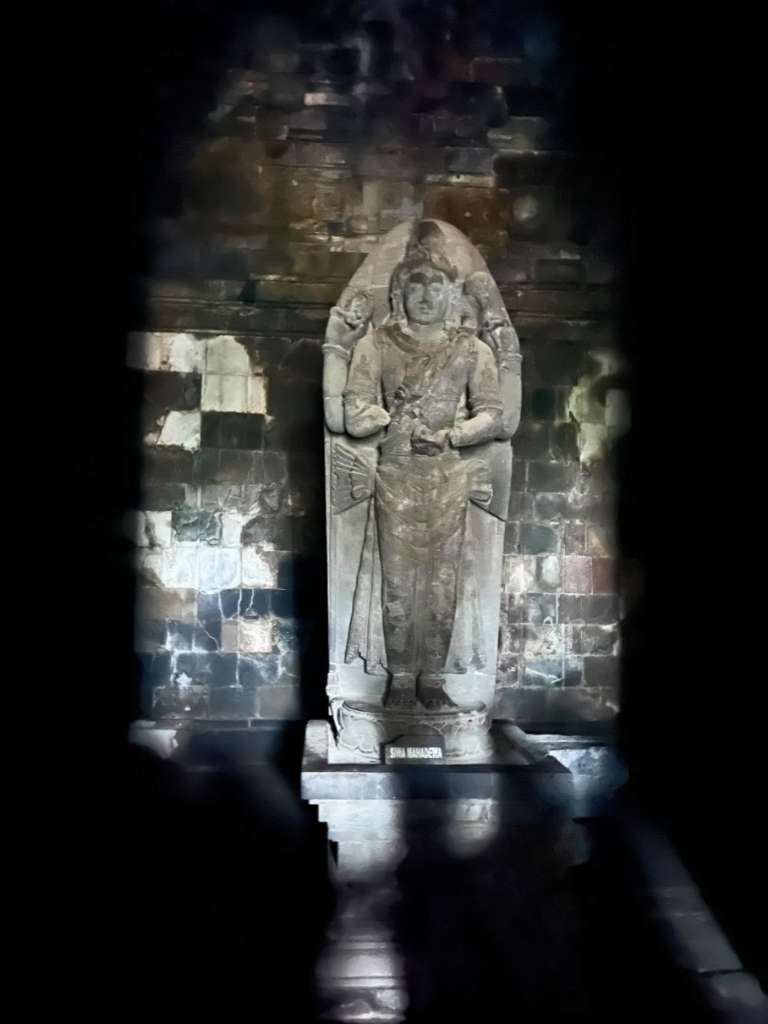
Statue of Shiva in the Shiva Temple
How to get to Yogyakarta
To get to Prambanan Temple, you’ll first need to get to the city of Yogyakarta in central Java, Indonesia. Luckily, Yogyakarta is easily reached with a 1 1/2 hour flight from either Jakarta or Bali.
As an alternate to flying, if you are coming from Jakarta, you also have the option of taking the train to Yogyakarta. This is what I did. I took the train from Jakarta to Yogyakarta. And for the return to Jakarta, I flew back.
The train in Jakarta leaves from Gambir Station and arrives in Yogyakarta about 8 hours later. Although it takes quite a bit longer than flying, it’s a fantastic way to see the countryside of Java.
How to get to Prambanan Temple
Once you’re in Yogyakarta, Prambanan Temple is about 45 minutes from the city center. There are a few ways to get there. What you choose depends on your budget, comfort level, and what else you may be doing for the day.
Book a Guided Tour
Several options are available through Viator. These tour options will show you the hours, cost, and where the pick-up point will be. Just make sure you know exactly what is and isn’t included before you confirm the booking. The pick-up location, entrance fees, and solo traveler fees are three biggies to pay attention to. You should also double check that you are booking the foreign or international visitor ticket, not the domestic tourist.
The average cost for a tour that includes transportation and entrance fee is about $45.
Take Grab or a Taxi
This is the most convenient way to get to Prambanan Temple. Just open the Grab app, enter in your destination, and schedule your pick-up.
Using Grab will cost about $7 each way.
A taxi will cost a little more than Grab. If you do go with a taxi, only use Bluebird taxis as they are the most reputable.
Hiring a Private Driver
Besides visiting Prambanan Temple, there were several places I wanted to see so hiring a private driver for the day made the most sense.
Your driver will take you wherever you want to go during a set timeframe. Drivers are also happy to tell you about local areas of interest and recommend the best places to eat.
A private driver should cost you about $35 for the day.
Prambanan Ticket Price
Tickets for visiting Prambanan Temple can be purchased online or at the entrance gate. There is no need to purchase tickets in advance either.
- Prambanan Entrance Fee: Approximately 375 000 IDR for adults ($25). A bottle of water is included in the ticket.
- Combination Tickets: If you book a “Continuity Package” for 625 000 IDR ($45) you receive entrance to both Borobudur and Prambanan Temples. You don’t have to visit both Borobudur and Prambanan in one day either.
Remember, the Ramanya Ballet is an additional, separate ticket.
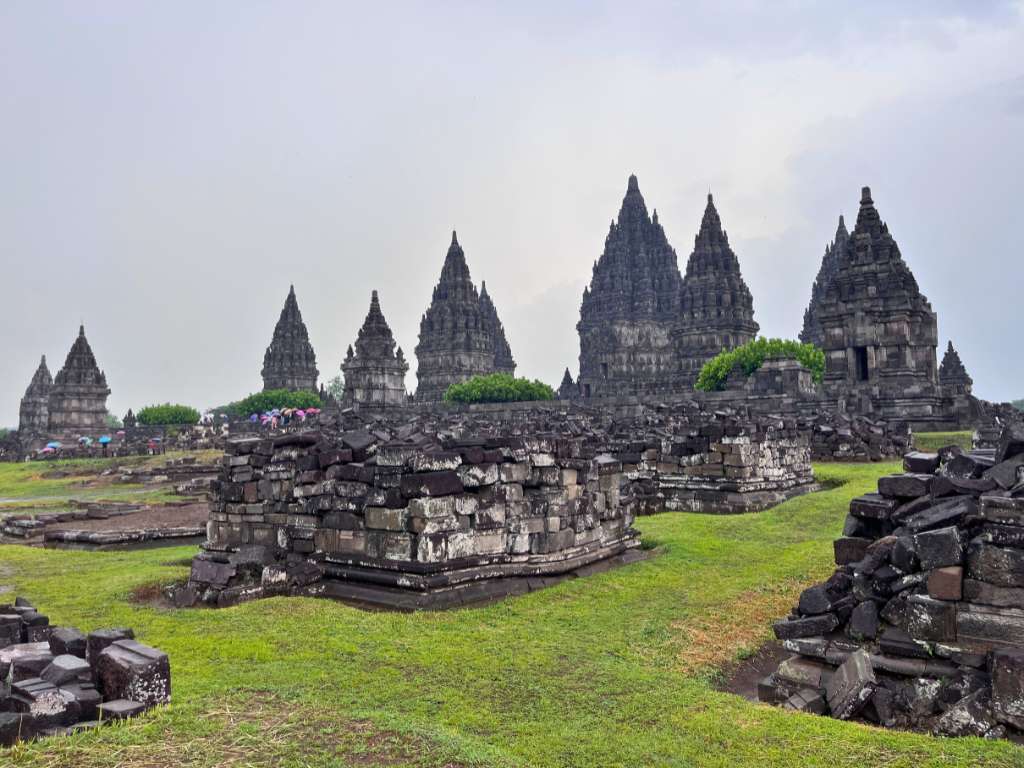
You could see the ruins of where other temples once stood.
Prambanan vs. Borobudur
While both Prambanan and Borobudur are UNESCO World Heritage sites and iconic landmarks of Indonesia, they represent different facets of the country’s rich cultural and religious history.
Prambanan, with its towering spires and intricate carvings, is the epitome of Hindu architecture in Indonesia. The temple complex is dedicated to the Hindu trinity and features a series of towering structures that emphasize verticality and the celestial realm.
In contrast, Borobudur is a Buddhist temple that embodies the spiritual journey towards enlightenment. Its design is horizontal, symbolizing the path from the earthly realm to nirvana. The temple’s structure, with its circular terraces and stupas, is more introspective, focusing on meditation and the progression of the soul.
Both temples offer unique and profound experiences, but while Prambanan impresses with its grandeur and intricate detail, Borobudur captivates with its serene beauty and symbolic depth.
Frequently Asked Questions
Q: Is Prambanan Temple worth visiting?
Yes! Prambanan Temple is worth visiting – especially in the rain!
Q: How long does it take to visit Prambanan Temple?
A: Allocate at least 2-3 hours to explore the main temples and the surrounding complex.
Q: Are there bathrooms at Prambanan?
A: Yes, there are restrooms, souvenir shops, and a few food stalls inside the complex.
Q: Can I take photos inside the temple?
A: Yes, photography is allowed, but please be respectful and avoid using flash inside the temples.
Q: Can I visit Prambanan Temple at sunrise?
A: Yes, if sunrise is 6:30 AM or later. The parking lot and ticket counter open at 6:30 AM but entrance to the courtyard doesn’t begin until 7:00 AM.
Q: Is Prambanan accessible for people with disabilities?
A: The main paths are relatively accessible, but some parts of the complex may be challenging due to stairs and uneven terrain.
Q: Can you visit Prambanan and Borobudur in one day?
A: Yes, you can visit both temples in the same day. I chose to visit on separate days so that I didn’t feel rushed. The temples are only 33 miles apart but there is so much traffic that it can take a couple of hours to get from one to the other.
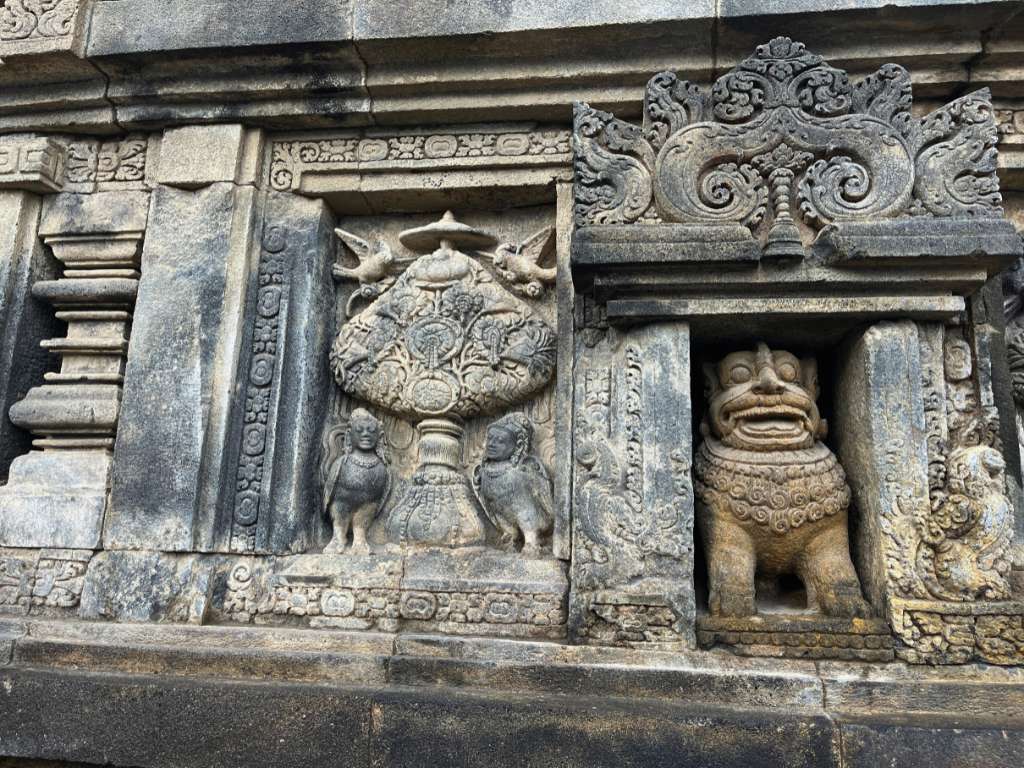
Such detail!
Resources to Book Your Trip
Flights
I like using Skyscanner to find flight deals. It searches hundreds of airlines and booking sites so you can compare prices, dates, and even airports in one place.
Accommodations
Booking.com is my go-to for hotels, guesthouses, and apartments. I like that you can filter for free cancellation and check reviews before you book.
Activities
For tours and experiences, I recommend GetYourGuide and Viator. Both have everything from walking tours to day trips, plus instant booking and mobile tickets.
eSIM
I’ve used Airalo and Saily for internet access when I travel. You can install the eSIM on your phone before you even leave home and there’s no need to swap physical SIM cards.
Airport Pickups
If you want a stress-free ride from the airport, check out Welcome Pickups. Your driver will meet you inside the terminal, help with your bags, and take you straight to your hotel.
Car Rental
Discover Cars makes it easy to compare rental companies so you get the best rate. You can see all the options and book in advance for peace of mind.
